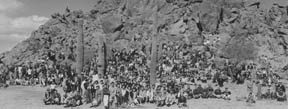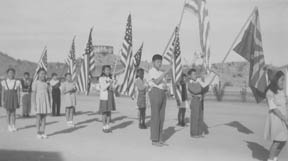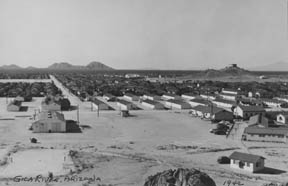America’s Concentration Camps
Gila River
July 20, 1942 – November 10, 1945
“There’s not much you can do there. You learn real quickly that this life is a little different. And I think you also learn that complaining isn’t going to get you anything.”
—Yoshimi Matsuura
Gila River was built in the arid desert valley of Southern Arizona. In the beginning, dust storms blew like blizzards through the camp. Masayo Arii recalls how “the strong winds would come up and the dust storm [would be] so bad that you couldn’t see the next barrack.”
The dust storms didn’t last, according to inmate Gloria Toshiko Imagire. After “about a year, we never had them anymore” because the inmates had planted gardens—oleanders and castor bean trees—that kept the dust down.
Cowboys and Indians
Gila River Relocation Center’s 16,500 acres were leased from the Pima Indian reservation, against the objections of the tribe.
There wasn’t much contact between the Pima living on the reservation and the inmates confined within the barbed wire, but even young children knew about their Indian neighbors. Helen Tanigawa Tsuchiya remembers a “three-year-old little girl, Indian girl,” who “used to ride her pony with her grandpa, and come up to the barbed wire. And then all the little kids would go over there and they’d try to touch the pony” through the fence.
As a young girl watching the western movies shown in the camp, Imagire imagined that the Indians she saw squaring off with cowboys on screen were the Pima, and that they would surely invade the camp and set everyone free. Sitting on a blanket on the ground in the camp’s outdoor “theatre,” she and her friends would tell each other, “The Indians are going to come get us out of here.”
Extra Money
Some inmates at Gila River earned extra income at the camp’s camouflage net factory, producing enormous nets that would be used to conceal the aircraft plants in Los Angeles. Yoshimi Matsuura took one of these jobs, noting that the private company that ran the factory paid considerably better than the $12–19 per month wages in camp—though far less than the company would have paid for labor outside the camp.
Many inmates had lost everything during the evacuation, or, as in Matsuura’s case, given their share of the sales of homes and businesses to older family members. “When we went to camp…I gave my family what we had, and my wife and I started with practically nothing.”
Quote credits
Yoshimi Matsuura, interview by Tom Ikeda, June 17, 2009, Twin Cities JACL Collection, Densho.
Masayo (Yasui) Arii, REgenerations, San Jose, p.21.
Gloria Toshiko Imagire, interview by Richard Potashin, October 17, 2008, Manzanar National Historic Site Collection, Densho.
Helen Tanigawa Tsuchiya, interview by Megan Asaka, June 16, 2009, Twin Cities JACL Collection, Densho.
![Farmers harvesting daikon radish. National Archives and Records Administration [Electronic Record]. Farmers harvesting daikon radish, Gila River.](../assets/images/camp-galleries/gila-river-camp-images/21-1980a.jpg) Enlarge
Enlarge
Farmers harvesting daikon radish. National Archives and Records Administration [Electronic Record].


